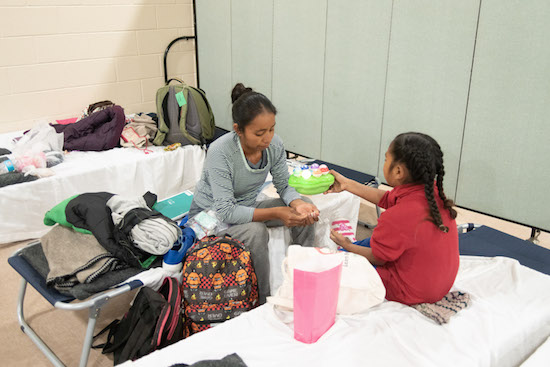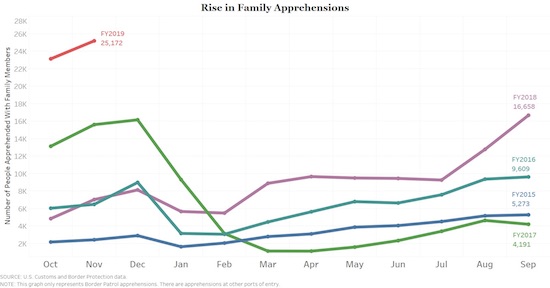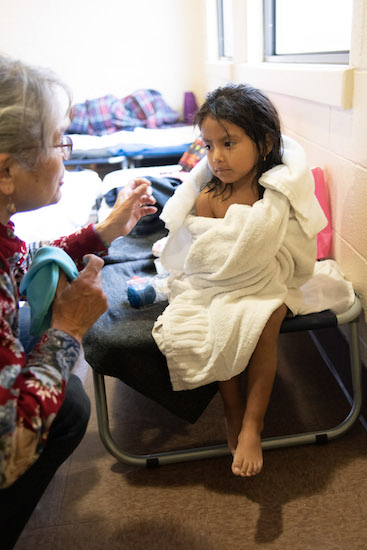ANTHONY, N.M. – Parents and children stumbled off the steps of an old charter bus to waves of applause and shouts of “Bienvendidos!” A small crowd of volunteers from St. Anthony’s Catholic Church had been waiting in the cold night air on a recent Monday, eager to welcome yet another wave of migrants just released from immigration detention in El Paso, Texas.
Inside, the parish hall was toasty, and volunteers were piling paper plates with fried chicken and mashed potatoes for the tired and hungry arrivals.

/ Photo by Don Usner/
“They need to see that even though they have been locked up, they are making a transition to where they finally feel free,” said Jorge Núñez, a volunteer in Anthony who himself was brought from Mexico to the U.S. as a child, in the 1960s. “We start clapping. It gives them that welcome feeling: ‘Now we’re not just a number. We are individuals, and these people are showing us love.’”
It is a typical night for Project Oak Tree, a volunteer effort that began in 2014 during a surge of asylum seekers from Central American countries engulfed by violence, political instability and poverty. Seven churches across Doña Ana County, of different denominations, have been opening and closing their makeshift shelters as migration patterns shift. Since June, they have sheltered more than 1,500 men, women and children, according to Lonnie Briseño, the Catholic deacon who heads the effort.
When migrant families began arriving at the U.S.-Mexico border in earnest five years ago, U.S. Immigration and Customs Enforcement (ICE) provided a safety net for fragile families by vetting their sponsors and facilitating their travel to destinations far from the borderlands. But in October, Homeland Security Sec. Kirstjen Nielsen effectively ended that “safe release” protocol, telling Congress that her department, which houses ICE and the U.S. Border Patrol (among other agencies), was overwhelmed.

The situation has worsened in recent months, as a smuggling network operating out of Guatemala began regularly dumping groups of hundreds of Central Americans in the desert south of the remote Antelope Wells port of entry in southwest New Mexico. With the authorities overwhelmed, the families are being released from detention with no help – and no idea of how to get where they’re going.
Churches, charities and hospitals across southern New Mexico have stepped in to fill the gap. Their efforts come on the heels of the deaths of two Guatemalan children after they were taken into Border Patrol custody in December.
Each day, Briseño awaits a text message from El Paso’s Annunciation House shelter with the count of migrants being released, so volunteers in New Mexico know when to prepare. They are on call to do laundry, organize clothing donations, cook hot meals, set up and take down cots and clean showers – and they have kept at it week after week, for the past eight months.
The project draws its name from an Old Testament story. “Abraham was sitting outside his tent,” Briseño recounted. “There were three strangers coming down the road. He brought them in to rest under an oak tree and provided them water and a meal to eat and rest. When you think about it, that’s what we do.”
Locals volunteer weekly in New Mexico’s most populous border county, from the dairy and pecan-farming community of Anthony to the state’s second-largest city – Las Cruces – and nearby Mesilla, a historic town that remained a disputed part of Mexico five years after the Treaty of Guadalupe Hidalgo ceded the rest of New Mexico to the U.S.
These are places that are culturally imbued with the border, where Spanglish is spoken liberally and families have strong ties on both sides. But unlike nearby El Paso – a metropolis of 800,000 that is known as the Ellis Island of the Southwest – these southern New Mexico towns rarely face border crises head-on.

/ Photo by Don Usner/
“I just think we owe it to any child to make sure their health and well-being is being protected and addressed,” said Janis Gonzales, president of the New Mexico Pediatric Society. “Regardless of where they come from or what the ultimate decision is about whether they stay here or not, we need to make sure we are treating them right while they are here, so we are not making things even worse for them.”
On another recent night, in the parish hall of Mesilla’s Basilica of San Albino, Ingrid López sucked on oranges as her 53-year-old father, Ovidio López-Tum, traced the scars of violence, extortion and poverty he sought to escape: the slice of a machete across his left cheekbone and left hand, the broken clavicle. He lifted his pants leg to reveal the electronic ankle monitor strapped there by ICE.
The farmworker left his wife and four other young children in rural Guatemala and crossed the southern Mexican border at a place called Gracias a Dios – “Thanks to God” – in mid-December. With the aid of a smuggler, they headed north on a relentless route with few stops to eat or sleep. Ingrid became severely ill after two days on the road.
“When we were in Mexico City, she had a fever; she was vomiting and had diarrhea,” her father said, shaking his head as the fear came back to him. “And I thought about going back. I really thought about going back. But thank God there was a woman who had some medicine. They saw how bad off she was.”
As he spoke, snow fell outside in fat flakes that neither of them had ever seen. Children gathered in the doorway, marveling.
Just then, a volunteer beckoned López-Tum to a side room, where Briseño and several volunteers had spent the last few hours contacting sponsors, booking plane reservations and buying bus tickets for families headed as far away as Massachusetts, Kentucky, Virginia and North Carolina.
López-Tum held an official ICE document with the address of a woman who said she will receive him and his daughter, along with a date to appear at an immigration office nearby. More than 2,000 miles from home, they would leave the next morning for the Gulf Coast. Another 1,300 miles to a new life.